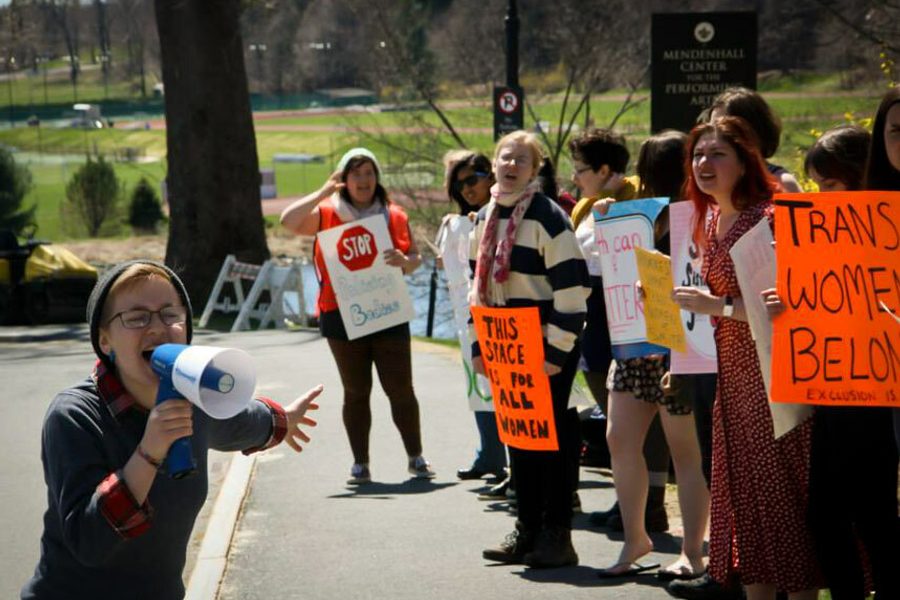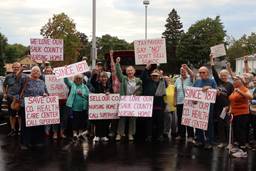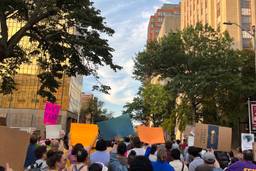Smith’s Pronoun Problem
Students protest the school’s admissions policies regarding trans women.
Jude Ellison Sady Doyle

In April, dozens of students at the all-women’s Smith College in Northampton, Massachusetts, rallied outside the white Colonial building that houses the school’s admissions office. They were there to protest an admissions policy that they say discriminates against trans women. The action not only put pressure on Smith to become a more welcoming place for trans students, but also reignited a very old debate about transgender issues and “woman-only” spaces.
This is an established sore spot for Smith. While the school’s website says that “an application from a transgender student is treated no differently from other applications,” in 2013 a transgender woman named Calliope Wong had her application rejected, twice, on the grounds of her sex. On Wong’s blog, she wrote that the admissions department initially told her that if she was referred to by female pronouns in the standard application materials — high school transcript, three letters of recommendation and optional standardized test scores — she would be eligible for admission. Then her application was denied because her high school transcript described her as “male.” After working with her school to change the transcript and re-apply, she was rejected again, based on her FAFSA application, which also described her as male.
Wong posted to her blog a photo of her final rejection letter from Dean of Admission Debra Shaver, which included the line, “Smith is a women’s college, which means that undergraduate applicants to Smith must be female at the time of admission.”
The situation raised substantial outcry. In response, Smith said it would no longer take into consideration gender markers on financial-aid forms. However, the school’s “Gender Identity and Expression” policy still reads, “Smith expects that, to be eligible for review, a student’s application and supporting documentation (transcripts, recommendations, etc.) will reflect her status as a woman.”
This, opponents of the policy argue, paves the way for the same transcript problems that plagued Wong the first time around. It also displays an ignorance of the barriers facing transgender women. Our society currently assigns babies a gender at birth, stamping them as officially M (male) or F (female) only a few hours into their life, based on the shape of their genitalia, before they get to have any say on the matter. A person’s legal documentation, given name and, yes, school records, will reflect that assigned gender throughout her life, unless she goes through the process of officially changing them. For cisgender people, who grow up to identify with their assigned gender, this doesn’t pose a problem. But transgender people realize — often very early in life — that their assigned gender doesn’t reflect their actual gender identity. A transgender woman, for example, is a woman who was assigned “M” on her birth certificate; a transgender man, vice versa. Some trans people identify as non-binary or genderqueer or a host of other identities that don’t fit into the two established “male” and “female” categories.
The issue of documentation can be a lifelong struggle for transgender women. According to transgender advocate and writer Katherine Cross, “in most parts of the United States, ensuring that all of your documents ‘consistently identify’ you as female requires a surgery that costs at least $18,000.” She notes that some states bar changing the gender on a birth certificate even post-surgery.
Although Smith doesn’t require legal documents like driver’s licenses or birth certificates, its policy still has what Cross calls a “disproportionate impact” on transgender women who apply: The current process requires that each transgender woman applicant have adequate family support, school support, resources and time to get her transcript, all three recommendations and her standardized-test results to “consistently” identify her as a woman. It also necessarily excludes transgender women whose schools, teachers or guidance counselors refuse to change their documents or use their preferred pronouns. This is why Smith’s student activists want to change the policy so that an applicant’s gender can be confirmed merely by including a supplemental letter from a trusted adult — a social worker, counselor, employer or teacher — verifying that the applicant in question identifies and lives as a woman.
Genderqueer writer and activist s.e. smith notes that the statements about Smith students needing to be “female at the time of admission” are suspect as well: “Notably, Smith includes a spectrum of nonbinary students, including genderqueer, transmasculine and other non-normative gender identities. Unlike Calliope Wong, they aren’t women…What she and other trans women are in essence being told is that no matter how they identify, they’re really men — and people who aren’t even women matter more than them, in Smith’s estimation.”
Sarah Fraas of Smith Q&A (a student-run group whose motto is “Q:Trans Women at Smith? A: TransWomen at Smith!”) tells In These Times that the group organized the protests because negotiations with the school had broken down. “The administration has made it abundantly clear that they have made all the changes they want to, even when a trans woman student specifically explained that what they are doing is excluding women from a ‘feminist’ institution,” she says.
It’s this idea of Smith as a feminist space excluding trans women that ties the debate into one of the ugliest chapters in feminist history. In the 1970s and 1980s, so-called radical feminists were enthusiastic about the idea of a “women’s culture,” a set of female-only and protected spaces where women could find some breathing room from the patriarchy. But their take on “women’s culture” was often profoundly essentialist: To participate in this glorious and welcoming all-girls sisterhood, you needed a vagina. And transgender women were cast as “imposters,” invaders and ominous spies sent from the patriarchy to dismantle the movement (because clearly, if the patriarchy wanted to do anything, it was listen to a bunch of folk music at the Michigan Womyn’s Music Festival—which excludes transgender women to this day).
Intersectional feminists have identified the rather glaring problem with this idea of “sisterhood”: It requires discrimination while claiming to fight it, and sacrifices trans women’s freedom to cisgender women’s comfort. Protesters at Smith held signs reflecting this: “Trans Issues are Feminist Issues” and “A Women’s College Is For ALL Women.” While challenging Smith’s outmoded idea of gender identity has required the protesters to come face-to-face with the virulently transphobic sectors within feminism, their struggle is moving proof that young women are working to make feminism a better movement for every woman — regardless of the pronoun on her documents.
Jude Ellison Sady Doyle is an In These Times contributing writer. They are the author of Trainwreck: The Women We Love to Hate, Mock, and Fear… and Why (Melville House, 2016) and was the founder of the blog Tiger Beatdown. You can follow them on Twitter at @sadydoyle.









